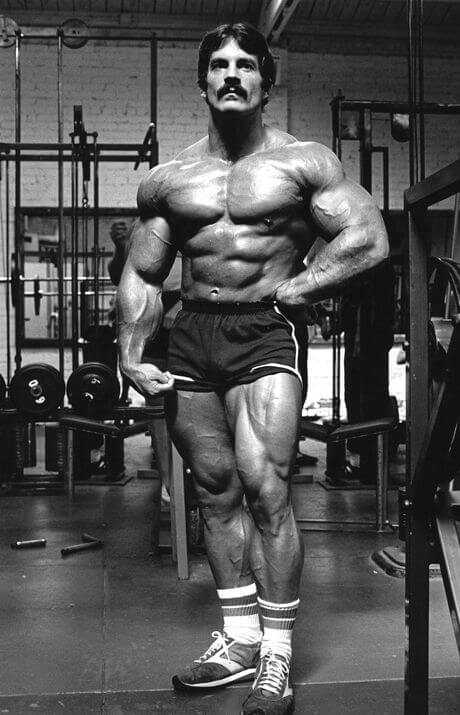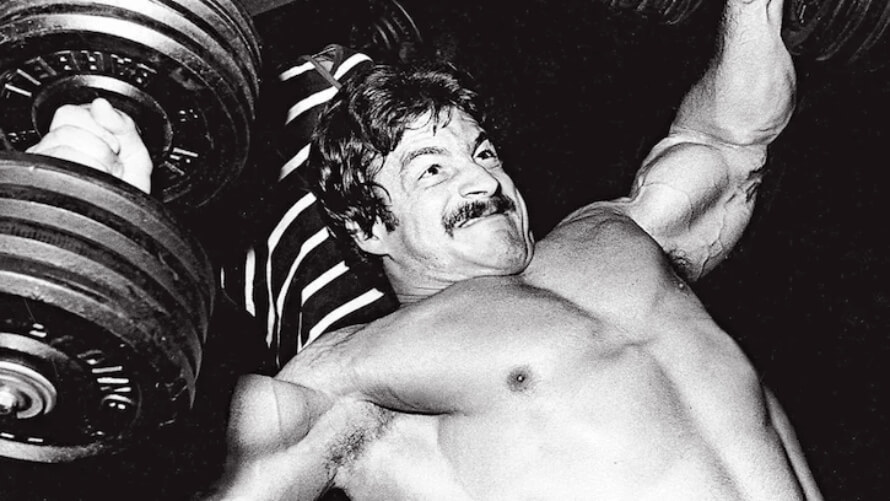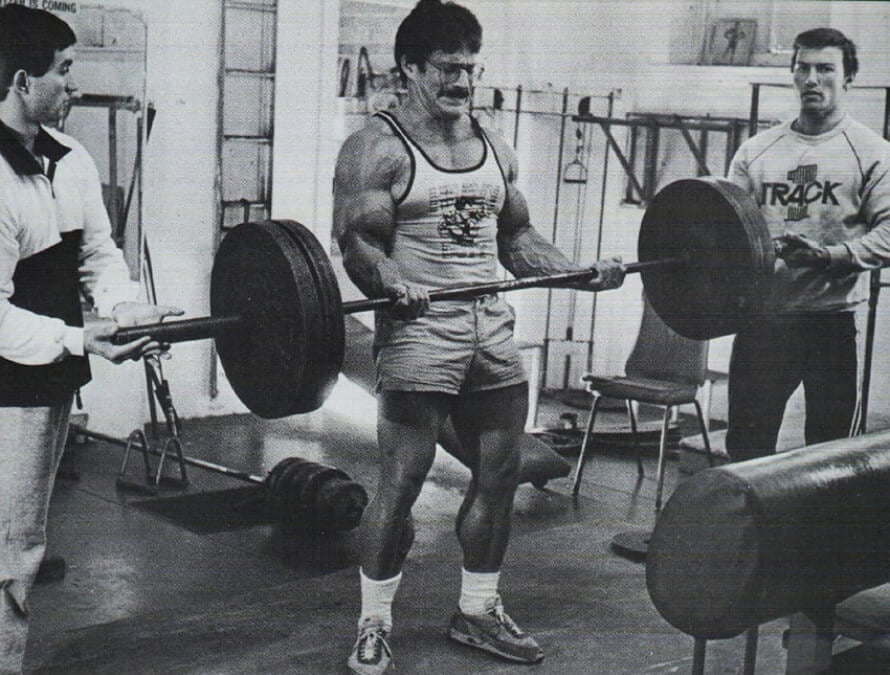The Complete Guide to Mike Mentzer’s Workout Routine
Most people think building muscle requires doing more—more sets, more reps, and more hours in the gym.
Mike Mentzer disagreed.
His workout routine took the opposite approach: short, brutally intense workouts followed by long recovery periods.
This approach worked for Mentzer and even inspired bodybuilding legends like Dorian Yates to follow his methods.
But how did Mentzer train exactly? And does his workout routine hold up to modern science?
In this article, you’ll get a full run down of Mentzer’s workout plan, learn what science says about his methods, and learn how to adapt his program for maximum results.
Key Takeaways
- The Mike Mentzer workout routine emphasizes low volume, training to failure, and extended rest between workouts, but these principles don’t align with how most people like to train or what research shows drives muscle growth.
- Mentzer’s workout plan is a 3-day split (chest and back, legs and abs, and shoulders and arms) with just one heavy set per exercise in each workout.
- The pros of the routine include a focus on progressive overload, training through a large range of motion, and tracking strength to measure progress.
- The cons include too little volume, training to failure, and infrequent workouts, which may limit muscle growth.
- Adjusting the Mike Mentzer workout routine by increasing volume, reducing intensity, and training more frequently makes it more effective and practical for most gymgoers.
- Who Was Mike Mentzer?
- Mike Mentzer’s Workout Routine: A Complete Guide
- Notes on Mike Mentzer’s Workout Routine
- Substituting Exercises on Mike Mentzer’s Workout Routine
- The Pros and Cons of Mike Mentzer’s Workout Routine
- Should You Follow Mike Mentzer’s Workout Routine?
- FAQ #1: How many sets do you do per body part on Mike Mentzer’s workout routine?
- FAQ #2: How does Mike Mentzer’s split compare to other 3-day splits?
- FAQ #3: Was Mike Mentzer natural?
Table of Contents
+Who Was Mike Mentzer?
Michael Mentzer was an American bodybuilder, businessman, and author.
His most notable bodybuilding achievement came in 1979, when he won the heavyweight class at the Mr. Olympia (although he lost the overall title to Frank Zane).
Mentzer developed “Heavy Duty,” a training method that prioritized lifting heavy weights for minimal sets, training to failure, and emphasizing recovery. He believed this approach was the most efficient way to build muscle and avoid overtraining.
After retiring from bodybuilding following the 1980 Mr. Olympia—a contest he controversially claimed was rigged in favor of Arnold Schwarzenegger—Mentzer dedicated his career to coaching others using his Heavy Duty principles.
One of his most famous followers was six-time Mr. Olympia Dorian Yates, who credited Mentzer’s methods with helping him break through muscle-gain plateaus later in his career.
Mentzer passed away in 2001 at the age of 49 due to heart complications.
Here’s a picture of Mentzer during his prime:

Mike Mentzer’s Workout Routine: A Complete Guide
Mike Mentzer’s workout plan changed throughout his career. In his first book, Heavy Duty, he outlined a push pull legs routine.
Later, Mentzer updated his approach. In his final book, High-Intensity Training the Mike Mentzer Way, he recommended a new split organized like this:
- Day 1: Chest and back
- Day 2: Legs and abs
- Day 3: Shoulders and arms
Here’s a detailed breakdown of this newer Mike Mentzer routine:
Day 1: Chest and Back
- Dumbbell fly (pre-exhaustion set): 1 set of 6-to-10 reps
- Incline bench press: 1 set of 1-to-3 reps
- Cable pullover (pre-exhaustion set): 1 set of 6-to-10 reps
- Reverse-grip lat pulldown: 1 set of 6-to-10 reps
- Deadlift: 1 set of 6-to-10 reps
Day 2: Legs and Abs
- Leg extension (pre-exhaustion set): 1 set of 12-to-20 reps
- Leg press: 1 set of 12-to-20 reps
- Standing calf raise: 1 set of 12-to-20 reps
- Sit-up: 1 set of 12-to-20 reps
Day 3: Shoulders and Arms
- Dumbbell lateral raise: 1 set of 6-to-10 reps
- Bent-over dumbbell lateral raise: 1 set of 6-to-10 reps
- Reverse-grip lat pulldown: 1 set of 6-to-10 reps
- Triceps pushdown (pre-exhaustion set): 1 set of 6-to-10 reps
- Dip: 1 set of 3-to-5 reps
Notes on Mike Mentzer’s Workout Routine

At first blush, Mike Mentzer’s program looks simple.
But if you want to follow it correctly, you also have to adhere to his guidelines around rest, warming up, training to failure, and so on.
Here’s everything you need to know.
Rest Between Workouts
Mentzer believed that recovery was just as important as the workouts themselves, which is why he recommended taking 4-to-7 days of rest between sessions.
He didn’t prescribe a rigid schedule (e.g., train every Monday, Wednesday, and Friday). Instead, he structured his routine into Days 1, 2, and 3 because your need for rest can vary based on your progress and circumstances.
Mentzer suggested starting with four days of rest between workouts. For example, if you do Day 1 on Monday, you’d complete Day 2 on Friday, and Day 3 the following Wednesday.
If something interferes with your training schedule—work, travel, or fatigue, for example—he advised waiting an extra day rather than rushing back to the gym.
According to Mentzer, as you build muscle and strength, your recovery needs increase, so he encouraged extending the rest period to 6 or 7 days, or even longer, as you get more experienced in the gym.
RELATED: The Definitive Guide to Muscle Recovery
Training Time
Mentzer emphasized the importance of choosing a training time that works with your schedule and energy levels.
Some people perform best in the early morning, while others prefer the late afternoon or evening. Mentzer believed the optimal time to train is when you feel focused and ready to give your best effort.
RELATED: What’s the Best Time of Day to Lift Weights? What 35 Studies Say
Warm-up Sets
Mentzer believed warming up for each exercise was essential, but he also felt it should be quick and efficient to avoid wasting energy you could spend on your all-out sets.
For example, if your heavy set of deadlifts is 165 pounds for 7 reps, Mentzer suggested starting with 115 pounds for 7-to-10 reps. Follow this with a second warm-up set of 145 pounds for 2-to-3 reps, which helps mentally prepare you for the heavier set to come. After this, you’re ready to train.
If you’re performing an exercise as part of a pre-exhaustion superset (more on this soon), he advised warming up with the compound exercise. For instance, when combining the leg extension and leg press, warm up on the leg press.
RELATED: The Best Way to Warm Up For Your Workouts
Pre-Exhaustion Sets
After finishing a pre-exhaustion set, Mentzer recommended going immediately into the next exercise. For example, after finishing your pre-exhaustion set of dumbbell flys, you should immediately begin the incline bench press.
After performing sets of other exercises, he suggested resting until you feel recovered, but no longer. This means that as your fitness improves, you can typically finish Mentzer’s Heavy Duty training program in less and less time.
Rep Timing
According to Mike Mentzer, “rep timing” was a key aspect of training. He believed that to maintain proper form and safety, and to ensure the target muscle—not momentum—is doing the work, you must take 4 seconds to lift the weight, pause for 2 seconds at the top of each rep, then lower it for another 4 seconds.
RELATED: Should You Lift Weights Fast or Slow? The Quick and Dirty Guide
Training to Failure
One of the cornerstones of Mike Mentzer’s Heavy Duty workout program was the emphasis on training to failure—the point at which you can’t perform another rep with good form.
In fact, he believed that reaching complete failure during your heavy set of an exercise was the greatest driver of muscle growth.
He referred to reaching failure as passing through the “break-over point,” the threshold below which you don’t stimulate growth and above which you do.
RELATED: Does Training to Failure Help You Build More Muscle? What Science Says
Progressing
Mentzer emphasized the importance of progressively increasing the intensity of your workouts. For him, the best way to achieve this was through progressive overload—lifting heavier weights over time.
For example, if this week you can curl 100 pounds for 6 reps and next week manage 10 reps with the same weight, you should increase the weight enough the following week to bring your max reps back down to 6.
He also advised not stopping a set just because you hit a target rep range. If your goal is 10 reps but you can do 13, push for 13. When you reach the upper end of your rep range (such as 10 reps in a 6-to-10 range), add about 10% more weight in your next workout.
RELATED: What Is Progressive Overload Training?
Tracking Your Training
Mentzer believed the only reliable way to measure your progress was by tracking your strength increases. Metrics like how sore you feel, whether you achieve a “pump,” or gut feelings about your performance are, in his words, meaningless.
To properly gauge your success, Mentzer recommended recording the details of every workout. This includes the date, exercises performed, weights used, reps completed with proper form, and even your body weight at the start of each session.
The logic is simple: If you’re consistently increasing the weight you lift or the reps you complete, your muscles are growing and adapting. If not, something in your approach—rest, intensity, nutrition, or recovery—is holding you back.
Substituting Exercises on Mike Mentzer’s Workout Routine

While Mentzer chose the exercises in his program because he believed they were the most fitting, he allows you to substitute them periodically if you have problems performing them (because of injury or access to equipment, for example).
Here’s are his recommendations for substitutions:
- Dumbbell fly: Cable crossover or pec deck machine
- Incline bench press: Flat barbell, dumbbell, or machine bench press or dip
- Cable pullover: Dumbbell or machine pullover
- Reverse-grip lat pulldown (Day 1): Barbell, dumbbell, or machine row or chin-up
- Deadlift: Shrug and leg curl
- Leg extension: Mentzer says you can’t substitute the leg extension, but sissy squats would work well.
- Leg press: Back squat
- Standing calf raise: Leg press calf raise or donkey calf raise
- Sit-up: Hanging leg raise
- Dumbbell lateral raise: Machine lateral raise, upright row, behind-the-neck press, or machine shoulder press
- Bent-over dumbbell lateral raise: Bent-over cable raise
- Reverse-grip lat pulldown (Day 3): Straight-bar curl, preacher curl, chin-up, concentration curl, or machine curl.
- Triceps pushdown: Skullcrusher, machine triceps extension, or overhead triceps extension,
- Dip: Close-grip bench press
The Pros and Cons of Mike Mentzer’s Workout Routine
While he may have positioned himself as “the thinking man’s bodybuilder,” Mike Mentzer’s workout program isn’t perfectly aligned with our modern understanding of what drives muscle growth.
To evaluate what Mentzer got right and where he may have missed the mark, let’s explore the pros and cons of his training methodology through the lens of science.
Pros
Mike Mentzer’s training routine emphasized progressive overload, which research shows is the primary driver of muscle growth.
He also championed training through a large range of motion, which evidence also suggests is better for gains than training through a short range of motion.
Another aspect of training he got right was tracking.
Mentzer knew soreness or “the pump” weren’t reliable ways to measure progress. Instead, he encouraged people to focus on tracking increases in the weight they lift, which is an objective sign of muscle growth.
Cons
One of the most controversial aspects of Mike Mentzer’s workout program is its low training volume (number of sets). Although he presented strong arguments for this approach, research consistently shows that doing more sets—at least up to a point—leads to greater muscle growth than doing fewer.
RELATED: How Many Sets Should You Do for Muscle Hypertrophy?
Mentzer’s insistence on training to failure also appears misguided. While he believed it was essential for growth, studies now show that stopping 1-to-3 reps short of failure can be just as effective and likely improves recovery.
His recommendations for training frequency were similarly flawed. While rest is important, evidence shows that muscles are typically ready to train again within 48-to-72 hours. Therefore, waiting seven days between workouts likely sacrifices gains.
Should You Follow Mike Mentzer’s Workout Routine?

Mike Mentzer’s workout routine has plenty of merit, but in its original form, it’s unlikely to suit most people.
The low volume, training to failure, and long breaks between workouts don’t match how most people like to train or what science shows works best for muscle growth.
That said, with a few simple adjustments, Mentzer’s program can be an effective and practical way to train. For example:
- Increase Volume: Instead of performing just one set per exercise, do 3 sets. This will improve your results while still keeping workouts brief.
- Reduce Intensity: Stop 1-to-3 reps shy of failure in every set. This is enough to build muscle without causing recovery issues.
- Adjust Frequency: Training 3 days per week is a better schedule than training once every 4-to-7 days. Scheduling workouts on Monday, Wednesday, and Friday is a good way to do this.
- Add Lower Body Volume: The upper body muscles get more volume than the lower body on Mentzer’s program. To even things out, add 3 sets of a compound lower body exercise (e.g., the lunge, hack squat, or Bulgarian split squat) after the leg press.
- Rearrange Exercise Order: Pre-exhausting your muscles is an ineffective way to train. Instead of doing isolation exercises as pre-exhaustion sets, flip the order so you perform compound exercises first.
With these tweaks, Mentzer’s workout routine becomes more balanced, sustainable, and effective for most gymgoers.
FAQ #1: How many sets do you do per body part on Mike Mentzer’s workout routine?
Mike Mentzer’s workout routine calls for just one working set per exercise, which he believed was enough to stimulate muscle growth if you take it failure. This translates to roughly 1-to-2 sets per body part per week, depending on how long you leave between workouts.
FAQ #2: How does Mike Mentzer’s split compare to other 3-day splits?
In its original form, Mike Mentzer’s split probably isn’t as effective for muscle growth as, say, the push pull legs or full-body splits, which train your muscles more frequently. By tweaking it slightly, however (more on the specifics above), you can make it comparably effective.
FAQ #3: Was Mike Mentzer natural?
Mike Mentzer admitted to using anabolic steroids during his bodybuilding career.
RELATED: 6 Things You’ve Always Wanted to Know About Steroids
The post The Complete Guide to Mike Mentzer’s Workout Routine appeared first on Legion Athletics.
https://ift.tt/LumVFar December 05, 2024 at 07:00PM Legion Athletics
Comments
Post a Comment